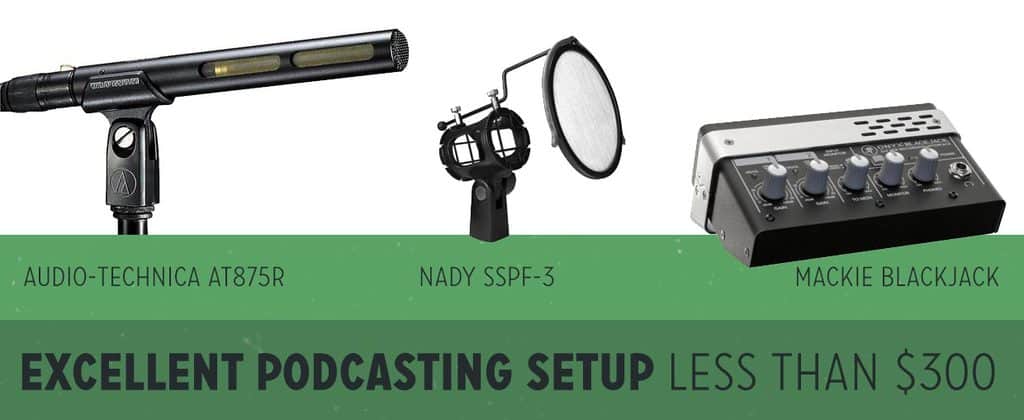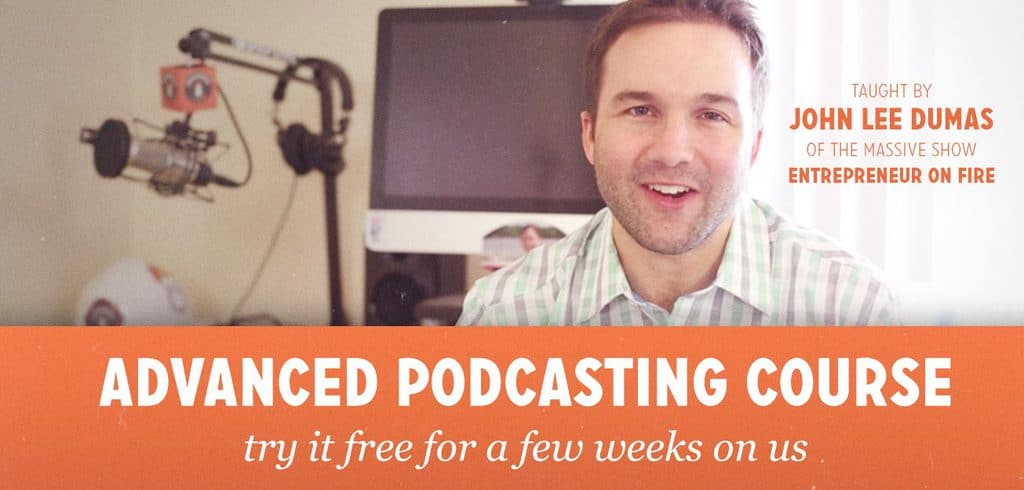The Podcaster’s High Quality Microphone Shootout

Today we are doing a test to see if the hype is true about high quality podcast microphones: is there really a mic out there that can make your voice sound amazing, if so, which one is it and is it worth the cost.
This test is for pro podcasters who care about both sounding great and not needing to take out a loan to buy the necessary gear.
I created a video for the test which you can watch here:
Table of Contents:
- Test Criteria
- How to Judge Audio for Yourself
- Test Files
- Background Noise Results
- The Multifunctional Winner (to my ears)
- Further notes
- So, What Should You Buy?
- Grow Your Show
- Your Questions
Test Criteria
A note about the test author: I've been working with audio in professional and hobby environments for about 15 years. I don't know it all, but I know what it's like to produce a #1 podcast every week for a few years.
So in this test I focus on what I think is most important for real podcasters. This is for us, the new kids trying to make the best possible show we can (often times out of bedrooms and basements).
So here's the criteria I'll judge these microphones on:
1. Background noise sensitivity.
We run a podcast here called The Fizzle Show. Four of us on the show, often at least 3 in the same room. It can lead to a lot of background noise in the podcast, which sounds unprofessional.
Background noise is important for ANYONE podcasting. When someone gives your podcast a shot, you DO NOT want to sound like you're in your mom's bathroom (even if you are). Some microphones are more sensitive to reverb, room noise and off-mic sounds than others.
So one of the things important to all of us is a mic's sensitivity to background noise. I'll be testing for that.
2. Vocal tone.
I'll obviously be testing for general quality of vocal tone coming from these mics, not just from my voice, but from a lady, and another man with a deeper, more bass-heavy voice as well.
3. Price.
And finally, of course, price. We can't all afford a $500 microphone. We're here' to discover if the price of some of the renown podcasting mics are WORTH IT or not.
The mics I've chosen all fall in the $100-500 range. These are just about all microphones that use XLR cables, though I did include 1 USB mic in the test for good measure.
How to Judge Audio for Yourself
Use some good headphones.
Your ears are sensitive. To get the most out of this test you should have headphone monitors that can reproduce the sounds with enough resolution for you to tell the difference between the microphones.
A/B the recordings.
Your ears are also relative. The best way to judge these mics and pickup the differences between each is to go back and forth between the different tracks. It's like A/B testing; you can listen to track A, then B, then A, then C, then B, then C, then A, etc. In the youtube video above you can hover and skip around on the timeline to compare.
With great microphones what you can look for is the balance of WARMTH and DETAIL. The way a microphone handles this balance can sometimes feel smooth or harsh or gritty or crunchy {insert another weird adjective sound people use when they talk about this stuff}.
Make your own opinions.
Each of the mics changes the tone of the voice. Sometimes it's dramatic, other times it's subtle. Some you may like, some you may not. You should feel encouraged to make your own opinions on which ones sound best to your ears.
A note about the recording process: Each mic was carefully situated about 1.5 to 2 inches away from the subject, pointing directly at the mouth. The mics were set to as close to the same exact level as possible using a Motu 828 and a Motu 4 Pre (industry standard high quality audio interfaces and preamps). Then I added some extremely light compression and a very subtle limiter to the master output track.
Test Files
I obscured the names of the mics, calling them simply A B C D E F G, so you can listen without any bias. Below I'll share a link to the key so you can tell which letter corresponds to which mic. You can also download all the files to listen to the highest quality version (download button on each track).
And in the rest of the article I share my take on how these mics performed, a few surprises, and which mic is the best to go with.
Microphone A:
Female 1
Male 1
Male 2
Background
Microphone B:
Female 1
Male 1
Male 2
Background
Microphone C:
Female 1
Male 1
Male 2
Background
Microphone D:
Female 1
Male 1
Male 2
Background
Microphone E:
Female 1
Male 1
Male 2
Background
Microphone F:
Female 1
Male 1
Male 2
Background
Microphone G:
Female 1
Male 1
Male 2
Background
The Mics in This Test (in order of price):
(Note, links to equipment on this page use an amazon affiliate code so if you buy any of the mics through these links you support this blog.)
Telefunken M82 ≈ $400 — requires: $100 XLR audio interface, pop filter.
Shure SM7B ≈ $350 — requires: $100 XLR audio interface (but likely needs higher quality preamp to avoid hiss).
Heil PR40 ≈ $330 — requires: $100 XLR audio interface, pop filter.
Shure Beta 87a ≈ $250 — requires: $100 XLR audio interface, pop filter.
Rode Podcaster ≈ $230 — requires: nothing.
Audio-Technica AT875R ≈ $160 — requires: $100 XLR audio interface, pop filter.
Shure SM57 ≈ $90 — requires: $100 XLR audio interface, pop filter.
When you're ready, here's the key to which microphone is which.
Listen to the tracks or video above to hear for yourself before moving on to the rest of the article. Spoilers!
Introductory Thoughts
Depending on your experience, it can be very hard to tell the difference between all these recordings. Each microphone shapes the sound in unique ways. Good monitors and experienced ears can hear those differences.
That said, the differences can be subtle and it can feel like all these mics are pretty damn similar. These are all high quality mics and they perform better than your standard cheap USB mic (with the exception of the Rode Podcaster).
However, this test is for those of us who want to sound excellent, and to my ears there's a lot to talk about here. Let's start with background noise.
Background Noise Results
I was very disappointed in the off-mic noise sensitivity of all three of the spendy, sexy, often recommended mics. I'm talking about the Heil PR40, the Shure SM7B and the Telefunken M82. They were all much more sensitive to background noise than I hoped they'd be.
In fact, all of the mics (except for one) performed effectively the same on the background noise test. To my ears, each allowed the same amount of room bleed.
I expected the SM57 and the Rode Podcaster to perform poorly here. They did. But I was surprised to hear that EVERY MIC performed about the same here… except for one.
The one mic that performed better than the pack on background noise is microphone D in our test, Shure's $250 Beta 87a.

I picked up this mic because Marco Arment liked it so much in his great mic review. And I am glad I did. It sounds really good, very rich and smooth, striking a good balance of warmth and detail. I do find the treble/presence to be a little harsh on, but nothing that can't be fixed with a little EQ and/or de-esser.
Besides sounding great on each of the voices, the 87A is FAR LESS sensitive to off-mic sound. That means there's less room reverb, less dogs barking outside, less background noise overall. If you use this mic in your mom's bathroom it will have noticeably less room-noise. (Please don't record podcasts in bathrooms, you guys.)
But this is bit of a double edged sword. This microphone is very sensitive to how near/far you are to the mic. Moving just a little off mic will be noticeable and annoying to listeners, so you'll need to keep your face right in front of the mic, not moving around very much when you record.
I definitely recommend Shure's $250 Beta 87A for podcasters because it sounds better than more expensive mics and cuts out background noise better than any other mic I've tested.
Sidenote: thinking about background noise made me realize some folks are using the wrong mic on their show. For example, Jason Calacanis uses SM7Bs in his studio for This Week In Startups. They talk a bit off mic, don't monitor themselves on the headphones, and subsequently the listener hears a lot of the room sound in the recording. They'd do better with more of a shotgun mic like the Audio-Technica AT875R.
The Multifunctional Winner (to my ears)
The microphone that sounded consistently great across all the voices, to my ears, is microphone A in our test, the Audio-Technica AT875R.

This is the only shotgun mic on the list, and it's a small diaphragm condenser you can find for around $160.
I first purchased this mic for use as a video microphone (which it's great as). Then I tried it up close on a voice and was blown away by how good it sounded. But surely, I thought, It can't compare to the mic's I've always dreamt about, like the legendary SM7B, right?
Not only does it hold up, I like it better! The SM7B sounds dull and it's hard to drive well without a spendy pro preamp, the Heil PR40 — a so called "necessary purchase" from many podcast pundits out there — adds way too much crunchiness in the high mids on every voice I tested. the Telefunken M82, the most expensive mic of the pack, was just… alright.
I'm actually really sad to say that because I wanted to get in front of these mics and fall in love, regardless of price. But it didn't happen.
To be clear, every one of those mics I just mentioned are amazing. You can easily correct any issues with each in post production. These are professional mics, capturing a ton of the frequency spectrum.
But why pay $500 for a setup like that when you can get better sound for less?
(By the way, I'm currently making more videos about how to do much more professional post production on your podcasts. Signup here to get on the list and get those when they come out.)
So, the multifunctional winner, for me, is the Audio-Technica AT875R because it sounds literally excellent on all the voices and it doubles as a great mic for off-camera video use. (We use this for all our video use.)
With this mic you'll definitely want a pop filter. We use this this shock mount and pop filter. It’s cheap,
so I recommend getting a few in case one breaks. We’ve used these for over a year now and haven’t had any problems with it. Fits multiple mics, easy to adjust and cancels out all those pops and plosives.
Further notes
1. It's a bummer the best mics look so dumb.
One of the biggest pains about this for me about this test is that the best sounding mics look really dumb. I wanted the excuse to keep one of these big, professional looking mics like the Telefunken M82 or Shure SM7B. Oh well. We didn't exactly get into podcasting to look cool.
2. All of these mics are excellent, you just don't have to spend as much as you think for great sound.
I want to say this again: all of the mics I tested are high quality, professional, great sounding mics (the one exception would be the Rode Podcaster which I think sounds real bad for the price). You can capture and sweeten great sounding vocal content from all of them. It's just nice to know you don't have to drop a bunch of cash on some of the $300-500 mics.
So, what should you buy?
OK, so I'm going to share the gear I recommend you should buy based on a few different segments.
1. If you haven't launched your podcast yet:
What are you doing here? You should be getting your episodes out and building your audience. Pick up a $55 Audio-Technica ATR2100 USB mic and start recording episodes in your closet where there are lots of clothes to deaden the sound. Come back here and decide if you want to spend more when you've published your 50th episode.
2. If you want great sound for recording one person:
I recommend the Audio-Technica AT875R, and a shock mount + pop filter. You'll need an XLR audio interface to connect the mic to your computer. A solid choice would be the $100 Mackie Onyx Blackjack or the Focusrite Scarlet 2i4. (Note, the Audio-Technica mic does require phantom power and both the Focusrite and Mackie's listed have it.)

3. If you want great sound for multiple people in the same room:
For the microphone I recommend the Shure Beta 87A with a pop filter. If you only need 2 mics, the two audio interfaces mentioned above would be fine. If you need more, I highly recommend the MOTU 4 Pre, which we use and love on our show.
Grow Your Show
Hey, since you're researching how to make your podcast sound excellent, you may also want to learn how the pros grow their audience, setup interviews, and get their shows to flourish in iTunes. If so, checkout the Advanced Podcasting Course we've made.
(I think I'll get fired from my own company if I don't mention this here.)
Our Advanced Podcasting Course is taught by John Lee Dumas of the MASSIVE podcast Entrepreneur On Fire, so it's not just theoretical information, it's real training from someone who actually knows what they're talking about.
You'll take this course for free if you give Fizzle a try. Access to all our courses and the community Q&A is free for a few weeks, then it's only $35/month.
Your Questions
Alright, this was such an enlightening test for me. I've dreamed of using some of these mics for almost a decade, but could never justify the price. Now, after running this test, I realize I don't need to justify the price.
If you have any questions, please leave them in the comments below and I'll do my best to answer them. Cheers and happy casting.
Earn a living doing something you love.
Grow an audience and get paid for your work as an independent creator. Fizzle is where creators come to learn, share and make progress toward their online dreams.
I’ve taken a lot of courses and been involved in several paid communities since I started my business, but I’ve never ever felt like anyone CARED as much about seeing my reach my goals as the Fizzle Team. They show up for me as much as I show up for myself. Thank you SO much, you guys!
 Claire Pelletreau
Claire Pelletreau
ClairePells.com
📓 Articles & Announcements
-
8 Experiments to Spice Up Your Podcasting Routine
Is your podcast routine stuck in a rut? If so, we’ve got just what you need! Jane Portman from Userlist joins us on the blog today to share her podcasting genius. Keep reading for 8 experiments you can try when your podcasting routine needs spicing
-
Introducing Fizzle 2.0
Today is an exciting day for Fizzle. We’re announcing a complete refresh of Fizzle, including every aspect of our user experience – courses, content, live events and more. Since we first opened Fizzle in 2012, we’ve provided thousands of entrepreneurs and creators with training, coaching and community. Today, this refresh marks
-
The Secret to Creating Consistent Content (that nobody’s talking about)
Hands up if you easily create consistent content week after week without fail. My guess? Since you’re reading this article, that’s probably not the case. Despite what you may be thinking – you’re not alone. Lots of content
🎙️ Podcast Episodes
-
The EXITpreneur’s Playbook with Joe Valley
Joe Valley is an Author, Guest Speaker, EXITpreneur, Advisor, and Partner at Quiet Light. He has also built, bought, or sold over half a dozen of his own companies. Over the last nine years, Joe has mentored thousands of entrepreneurs whose goal is to achieve their own eventual exit. He
-
R&D Tax Credits with Tiffany Bisconer
Tiffany Bisconer is a CPA with over 20 years of accounting and tax experience. Tiffany worked with one of the top certified public accounting firms before becoming director of Acena Consulting. She combines her private industry and public accounting experience to work with CPA firms and directly with business owners
-
Behind the Scenes: Fizzle 2.0
This has been an exciting month for Fizzle! We recently announced a complete refresh of Fizzle, including every aspect of our user experience – courses, content, live events and more. Since we first opened Fizzle in 2012, we’ve provided thousands of entrepreneurs and creators with training, coaching and community.





